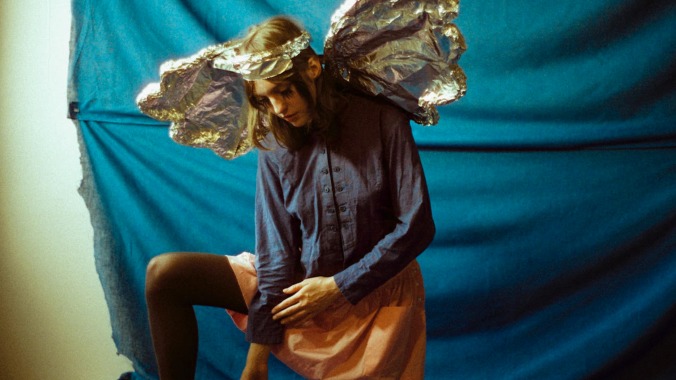Anastasia Coope is in Command
The Brooklyn artist unveils the influences behind her debut album, Darning Woman, and what inspired her transition from visual art to music.
Photo by Grace Conrad
For most of her life, music did not appeal to Anastasia Coope in any significant way. “I very unseriously did chorus when I was in grade school and maybe middle school. I was never musical,” says the 21-year-old Brooklyn artist. She furthers the sentiment again later in our conversation, stating that she was “interested in the stuff that my parents would play for me but from [ages] 10 to 15-16, I had a real lull in it. It really wasn’t something I was thinking about.”
Instead, Coope was more drawn to visual art as a toddler at a Montessori preschool, where she was encouraged to channel her emotions through a variety of collages, paintings and drawings. “I think that has always been my most tactical mode of expression or documentation for myself. I think once I started marking music, it felt like there was a large landscape of stuff that had been left undiscovered that doesn’t feel possible in painting,” she explains. “I think I’m a very fast, informational painter. I like getting information on a canvas and just leaving it. I’m quite unprescious as a painter. I think that recorded music, even just visually like the way that stems stack and information is stored on the screen, it feels like there’s room for a lot more precision and actual time spent. So maybe time is the biggest thing. Painting is very fast to me but recording music is much more geometric or celestial. It can be more ever-expanding than painting can be.”
When Coope received a laptop from her parents in preparation for college, it awakened an idea resting in her subconscious: “What would happen if I tried to record music?” She immediately began experimenting with the process, equipped with only GarageBand and a sense of fresh curiosity. “Very immediately, even before my interest in other people’s music was invigorated, my interest in my own music [was invigorated],” she says. “It was the genesis. I was really struck by how immediate it was and it felt like the most immediate click, but that’s sort of a boring word to use. It felt like the most immediate thing that had happened maybe in my life.”
She proceeded to sculpt an untraditional path in music for a novice musician, guided by the individual expression she found within the malleable art-form rather than from the influence of any specific musician or genre. At the time of writing and recording her debut album, Darning Woman, Coope was venturing into the sounds of avant-garde music and psychedelia with artists such as Charles Ives, Broadcast and Trish Keenan. However, Coope affirms that she drew the most significant inspiration from interviews with artists rather than the music itself, stating that she was “encyclopedic-ly tackling my version of music history, at least what sort of interested me because it was COVID so I was alone. I had a real moment with interviews, like people’s interviews so literally any band or musician or composer that I was even semi-interested in. I was scouring the internet on like the 20th page to find these interviews. I wasn’t reading any books or anything, but I was just reading and listening to a lot of interviews.”
Coope rummaged through the internet for conversations with musicians that resonated with her, poring over Amoeba’s “What’s in my Bag?” video series and interviews with artists like Floating Points and Laetitia Sadier. “I didn’t feel like I was utilizing people’s approaches to music as much as their approaches to thinking about stuff,” she continues. “The influences feel more deeply rooted in ideology than music.” Her conflicting identity as a New Yorker of the upstate variety and a born native to the city informed many of her early notions of artistry and creativity. She was born on 68th street in Manhattan and grew up in Cold Spring, a quaint village nestled along the Hudson River a little over an hour outside of the city. The distinctions between the two linger in her mind more often nowadays since she moved to Brooklyn several years ago.
“My parents both always worked in the city and my grandparents and the rest of my family live in Westchester closer to the city. So I always felt like I was going between the two,” she explains. “As a young kid, I was always projecting any creative idea I had onto the city, and then whenever I would go I would just be very excited to be somewhere metropolitan but I’m very glad that I grew up with expanses of green, I do miss that. By the time I was 15, I never wanted to be upstate. I always wanted to be in the city, so I spent most of my time near Union Square and Gramercy.”
-

-

-

-

-

-

-

-

-

-

-

-

-

-

-

-

-

-

-

-

-

-

-

-

-

-

-

-

-

-

-

-

-

-

-

-

-

-

-

-








































